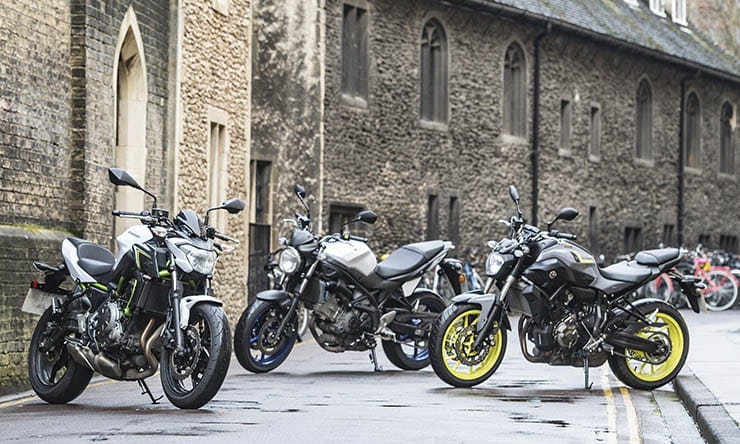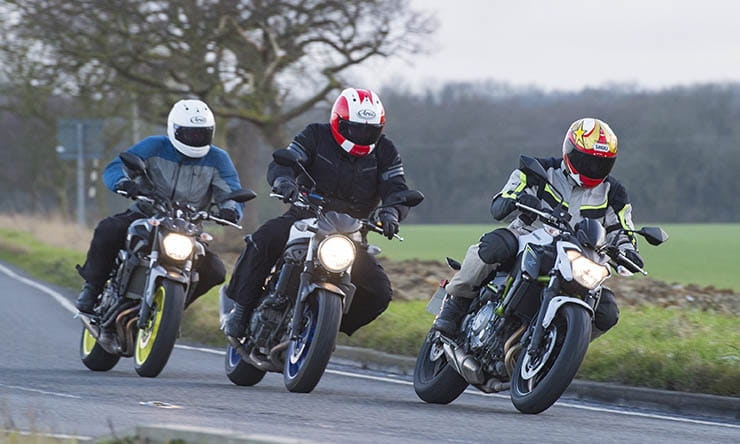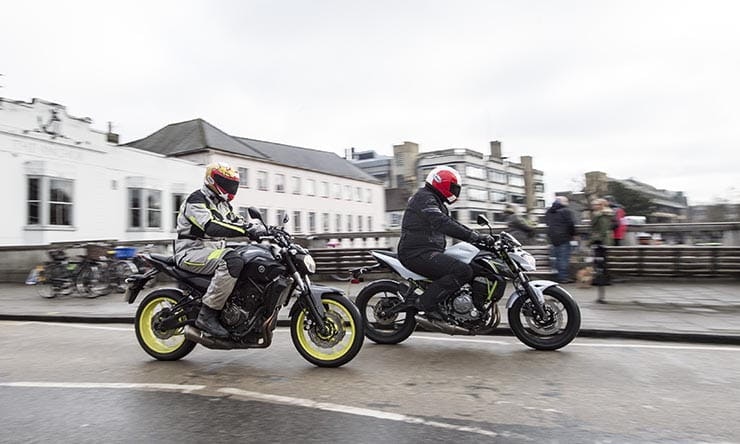Can Kawasaki's new Z650 topple the Suzuki SV650 and Yamaha MT-07 in the crown to be king of the middleweights? We sent experienced road testers Marc Potter, Jon Urry and Phil West on a road trip to Cambridge to find out...
Kawasaki’s new middleweight Z650 has just hit UK dealers and claims big changes and a 19kg weight loss over the ER6n it replaces. We rode the Z650 at its press launch in December, and know it’s good, but what’s it like on typical UK roads and against its biggest rivals in the city? In what is hotting up to be a big category of exciting smaller bikes, we took the new Kawasaki, Yamaha MT-07 and Suzuki SV650 to Cambridge for some city riding, and then on to some twisty B-roads to see for ourselves.
VIDEO REVIEW: 2017 middleweight shootout: Kawasaki Z650 vs Suzuki SV650 vs Yamaha MT-07
Seasoned road testers Marc Potter, Phil West and Jon Urry take the 2017 class of middleweight twins out for a group test.
Kawasaki Z650
It’s the usual Tuesday morning carnage on the A14 past Huntingdon and on to Cambridge. Filtering on the new Kawasaki Z650 makes you feel just how different the new bike is, and not just in the way that it looks.
The motor might be heavily based on the outgoing ER-6n, but the Z650 has been retuned for more mid and low-range torque, even at the slight loss of a couple of bhp because of Euro 4 changes. But what you get is a more user-friendly motor for day-to-day riding.
The motor has had a work over and now makes 67.07bhp (the ER6n made 71bhp) with new cams, a slimmer airbox, 36mm throttle bodies, new injectors, a new gearbox, new cooling system, and new exhausts and headers. There’s also a slipper clutch, designed more for newer riders on down changes, than for any race track progress.
You don’t miss the lower power output though, in fact it feels a hell of a lot more flexible, grown-up and more accomplished in the real world.
You can really feel the difference when dodging wing mirrors a rainy, miserable February day. It rumbles along gently. Where the old bike required revving to get any decent pull between cars, the Z650 bumbles along in fourth gear at 3/4000rpm and pulls smoothly.
In top gear at 75mph it’s doing 6000rpm with just a bit of vibration through the frame, but nothing like the old ER6n’s buzziness. It will accelerate in traffic in top gear by just rolling on the gas, where you’d be looking for fifth, or even fourth gear to shift in the fast-moving A-road traffic between 60 and 75mph on the old motor.
The 649cc parallel twin has gained a tiny bit more low-down torque at 48.45 ft-lb at 6500rpm, compared to the ER6n’s 47.2 ft-lb which came some 500rpm higher at 7000rpm.
But bigger than the changes to the engine, are the riding position, the chassis, and the weight loss programme the bike has been on.
Kawasaki, claim it is now some 19kg lighter, mostly thanks to a lighter steel tubular chassis using technology from Kawasaki’s range-topping H2 superbike, and a much lighter swingarm which no incorporates a centrally-mounted shock rather than the ER6’s side-mounted shock. It now weighs in at 187kg. That means it’s so much more manageable at low speeds than the ER6, and that’s saying something. But it’s still 5kg heavier than the lithe Yamaha.
As Kawasaki’s biggest-selling motorcycle in Europe in 2017, based on pre-orders, that’s important. Many are going to end up in the hands of new riders, just like the rider training favourite - the ER6n. It has plenty of steering lock, the clocks are easy to read in the UK gloom, the digital rev counter is centrally-mounted with the speedo and the rest of info like mpg, fuel range and mileage.
The slipper clutch is incredibly light at the lever, and the riding position seems to put you closer to the bike’s headstock than the old bike. You can feel the rear seat stopping you sliding back under heavy acceleration. It feels small, manageable and easy to ride in town. At speed it’s relatively comfortable too, and when you go a bit faster, the chassis feels taut and confident. The standard Dunlop D214 Sportmax tyres are perfectly suited to its all-round ability too, wet or dry.
It may not be a revolution, but the Z650 is good-looking, has some neat touches like the Z-shaped LED rear light, and feels as though it has grown into a proper full-size motorcycle, yet the 790mm seat height means that anyone can get on it and ride it easily.
The Kawasaki has moved on a long way, pushing it closer than ever to the Yamaha, and overtaking the Suzuki for practical day-to-day use. And, remarkably, when we rode it hard on the launch it gave 53mpg averaged all day. On rainy, British roads where we rode them fairly gently most of the time, it recorded 53.3mpg. Though, weirdly, it was the first to be looking for a petrol station at around 100 miles, according to the bike’s gauges, despite having the biggest claimed tank at 15 litres.
Yamaha MT-07
As we wait for our photographer, Gareth, at a service station on the way into Cambridge, we make full use of the heat coming out of the beige pastry oven. It's a great place to park our helmets and dry out our helmets and gloves.
Yet even in grim conditions, with torrential rain and three degree temperatures that are enough to take the spirit out of even keen motorcyclists, Jon is already enthusing about the Yamaha MT-07: “That bike is just brilliant, it’s no surprise that it’s Yamaha’s best-selling motorcycle in Europe, it has such a great engine.” Even if Phil isn’t sure about the styling, he agrees, but he is old that fluro isn’t really his gig.
To be fair, the Yamaha MT-07 is the most youthful-looking bike here, especially in its grey paint scheme with fluro wheels. I like it, others don’t. But it’s part of the MT range, and everything from the MT125 to the mighty MT-10 come in those family colours.
The SV650 is the most traditional looking of all the bikes, and the Kawasaki falls somewhere in the middle, but looks modern and worthy of its Z moniker, harking back to Kawasaki Z models of old.
The Yamaha is the funkiest looking bike, and also a massive success for Yamaha. It’s no surprise. That 689cc liquid-cooled parallel twin motor is the biggest capacity here and feels it too. It offers the biggest low down punch with a claimed 50ft-lb of torque and a claimed 74bhp at 9000rpm. But forget claimed figures for a second. We didn’t get chance to dyno them, but one ride and you’ll feel the low-down and mid-range of the bike. Ultimately it may not have the same high-end power as the Suzuki SV650 and its Suzuki-like top-end, or the revs of the Kawasaki, but it’s the best engine here by far.
Low-down it’s the strongest but perfectly fuelled, it has tons of mid-range too.
If you were told it was a 750 you’d believe it. In town on the tricky, greasy, traffic-laden roads of Cambridge, watching out for drain covers and suicidal, overly clever (but lacking common sense), students on pedal bikes dive across us for gaps. Thankfully, the MT is agile, its brakes are the best here for feel and power, and its Bridgestone BT023 tyre give good wet weather grip.
The upright riding position, and that stubby front-end means it feels as though there’s only the big digital display in front of you. All are similar on the motorway in terms of wind protection. That is, there isn’t really any!
Everything in front of you on the Yamaha is easy to read, and it feels the most expensive of the three bikes. The plastic protectors and bodywork are of high quality and the whole bike is well thought out. It’s light and manoeuvrable in town, the chassis feels light, it’s easy to turn and feels solid. It may be an entry-level bike, but the MT-07 is more than enough bike for bigger bike riders too. It can cover distance, do the regular commute and is easy to get on with for new riders. We managed 51.5mpg on our test.
The only thing that I don’t like is the rear shock. At one point I took our snapper for a lap of Cambridge as pillion. Gareth’s not a heavy guy by any means, weighing in at 75kg, but the bike sat so low at the back and there was barely any damping. I reported the same last year when we tested the bikes on the Isle of Man TT course too. It’s really noticeable when you push the bike to its limits.
But to be fair to Yamaha, the MT-07 isn’t for riding flat-out. Ridden the way Yamaha intended, and how customers will ride it, the MT-07 is a simply brilliant motorcycle. It’s exactly the same money as the Kawasaki too, at £6099.
Suzuki SV650
A year after its launch, the Suzuki SV650 is still the sportiest motorcycle here, and that's before you fit the optional Remus end can and blue anodised bits and bobs that came fitted to our test bike.
Based on the old Suzuki Gladius, but with some 140 changes to the chassis and 40 new engine components, the result is a bike that weighs 197kg wet, and makes a claimed 75bhp. That makes it the most powerful (claimed) bike here. It certainly feels like it has the most power on a run.
At £5699 the Suzuki SV650 is a brilliant bike for the money, and the cheapest one here. It may not have the modern looks of the Yamaha and the Kawasaki, but there’s a nice old school muscle bike vibe about it, especially with that blue stripe along the length of the bike, the way it hunches forward and the way it sounds on the road. It’s a good-looking naked bike, even if the optional blue anodised parts on our test bike should have stayed in the Nineties, along with stick-on piggy ears and purple headlight covers.
Like the others, you’d never guess it’s a 650 to look at. But it has the lowest seat height here at 785mm. The Yamaha comes in at 805mm, and the Kawasaki is a close second at 790mm. In truth they are all low, all narrow where it counts at the tank and even shorter riders will be able to get on them with both feet flat on the ground.
Unfortunately, that seat is hard when riding day-to-day, and at the front of the padding it feels like you’re sat on the frame rails. It’s certainly the least comfortable bike here. What you lose in comfort though you gain with sportiness. The only V-twin here is lazy and easy at low speed, boastful in the middle, and has the biggest, longest lasting top-end. That Remus can makes no difference to overall power, but adds a bit more soul to the bike. We’ve ridden it a lot as standard too, and even then it still sounds deep and bassy.
There’s nothing fancy on the chassis, the suspension is basic, like all the bikes here it’s non-adjustable other than for rear preload. Yet on a back road it gives the most feedback and the most confidence. It steers faster and is simply more point able on a twisty road. A real shame is that the brakes don’t match the rest of the package. There’s so little initial bite on the front brake lever that it’s a bit alarming after the warm, secure feeling you get from the Yamaha, and the power of the Kawasaki’s front brakes.
As Jon commented, a lot of Suzukis, even top flight GSX-Rs, are like this in the initial part of the travel and it’s something you get used too. Further down the lever travel there’s enough power.
In town it’s as easy to ride as the others. The gearbox is sweet, the riding position is upright and the power is fluid and gentle at low speeds. You can use much lower revs than the Kawasaki around town thanks to the extra grunt of the Suzuki.
It recorded 49.2mpg average on our real-world test.
It may be the heaviest, but it carries its weight well. It’s a great bike for the cash, and the sportiest bike here.
Verdict
This class is growing to be ultra-competitive, and the result is that we now have three brilliant motorcycles that are all great value for money and hard to choose between. That’s great news for any buyers.
The Suzuki is undoubtedly the biggest bargain, coming in at £5699 in standard trim, and it’s the sportiest bike here.
The Kawasaki Z650 has moved the game on for Kawasaki, offering riders a well-priced, brilliantly specced bike that feels much more like a grown-up Kawasaki than the ER6n it replaces. One of our test riders, Phil put the Kawasaki first in his opinion. It’s a fantastic motorcycle.
But when it came down to it, for real-world usability every day, combined with practicality and fun when you leave the city, the Yamaha MT-07 just pipped it for myself and fellow tester Jon. It’s a great motorcycle, with a better all-round, stronger engine than the Kawasaki and a bigger bike feel, yet it’s a motorcycle that is still ultra-friendly for learners. The best of both worlds in fact. It’s closer than ever, but the Yamaha is the deserved winner of this test.
Second opinion: Phil West
Suddenly, this category – middleweight roadsters/entry-level nakeds – is, with the arrival of the new Kawasaki, last year’s updated SV and the best-selling MT-07, shaping up to be one of the most competitive of all.
It’s also proving to be one of the best. Take the Suzuki, for example: this update of the already hugely and rightly successful SV650 is simply a helluva lot of bike for £5600 and one that all riders can have fun on.
In terms of separating them and finding a winner, however, I’d put it this way: each typifies the strengths of its parent manufacturer.
So, yes, the Suzuki is the oldest and cheapest of the three with a willing, proven engine, better handling than you’d expect and appealing, traditional styling.
The Yamaha is a more serious performance machine with a hugely impressive engine and is incomparable fun while being useful and unintimidating to novices. I still can’t fall in love with its weird looks, though, and in some places it looks like it’s either unfinished or bits have fallen off.
The new Kawasaki is, probably, the best all-rounder of the bunch – but it’s very close. The Z650’s handsome, solid and classy in a way the others can’t match – almost feeling like a bigger bike all round. The meatier engine is decent (although it fails to beat the Yam) and its chassis behaviour is without fault, too, although it does feel heavier than the others.
At the same price as the Yam, the Kwak somehow feels like you’re getting more bike for the money – even if its engine hasn’t quite the same pep. Then again, at over £400 less, if I was feeling skint, I wouldn’t be at all disappointed with the Suzuki either…
Second opinion - Jon Urry
There isn’t a bad middleweight in this test and each has their various plus and minus points, but there is one that feels special and that’s the Yamaha MT-07.
There is no escaping the fact middleweights are the cheap option, but with the MT-07, Yamaha has not only made it look anything but budget but also ride with true spirit thanks to the parallel twin motor. And for me that’s its major selling point.
The SV has the best chassis when it comes to sporty riding, but in a middleweight I’d rather have softer suspension and a physically bigger, and therefore roomy, riding position that creates a new rider-friendly character. The SV is a great bike, and the V-twin is still a beauty, but it isn’t as comfortable as either the Yamaha or Kawasaki due to its sporty focus, and its looks are dated.
The Kawasaki was the surprise package. Its look is fresh, the chassis a real surprise and a definite step forward in terms of handling when compared to the ER-6n. The engine is soulful and has more of a thumping feel than the smooth Yamaha, and it doesn’t rev as fast, which is why overall I’d pick the MT’s parallel twin over the Z650’s. And that’s basically what it all boils down to. The MT-07 is such a good bike due to its modern motor, where the other two are relying on tweaked versions of pretty old lumps, which is what has ultimately let them down.
Technical specifications
Photos and video by Gareth Harford


